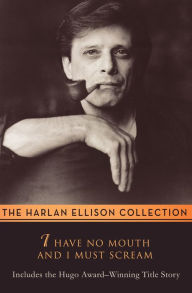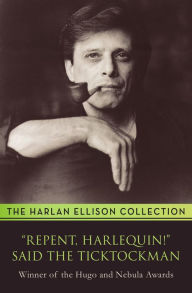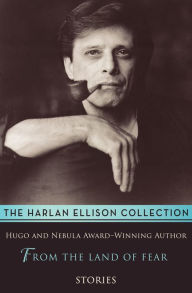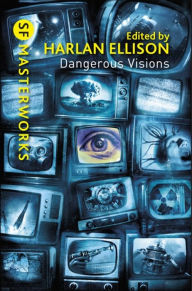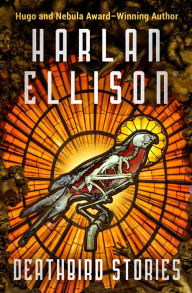10 Harlan Ellison Short Stories That Changed Sci-Fi
 There will never be another Harlan Ellison. Insanely talented, incredibly smart, legendarily prickly and difficult, and difficult to get along with if he didn’t like you (or sometimes even if he did), Ellison was one of the rare writers who transcended his own work to became an icon based solely on his personality. This is more impressive, considering said works rank with the most important and influential in science fiction history. Whatever your feeling about the man, who on more than one occasion pushed past “curmudgeonly” into outright abusiveness, there’s no denying his impact on the genre.
There will never be another Harlan Ellison. Insanely talented, incredibly smart, legendarily prickly and difficult, and difficult to get along with if he didn’t like you (or sometimes even if he did), Ellison was one of the rare writers who transcended his own work to became an icon based solely on his personality. This is more impressive, considering said works rank with the most important and influential in science fiction history. Whatever your feeling about the man, who on more than one occasion pushed past “curmudgeonly” into outright abusiveness, there’s no denying his impact on the genre.
Picking the most important Ellison short stories, much less ranking them, is a fool’s errand. But while almost everything Ellison wrote was influential to some degree, a short list of titles rise to the top. These ten stories aren’t just brilliant sci-fi, they changed the genre in ways large and small.
I Have No Mouth and I Must Scream
I Have No Mouth and I Must Scream
Paperback
$12.99
$13.99
“I Have No Mouth and I Must Scream”
If any single writer inspired Black Mirror, it’s Ellison. It’s difficult to sum up the influence of this 1967 story, which combines tropes about artificial intelligence, nuclear Armageddon, and the nature of existence and subverts expectations of good and evil and winning and losing—who, after all, can be said to be the victor at the end of this grim tale of a murderously hate-filled, all-powerful computer and the humans it tortures endlessly? The story also casually bends genres, launching from a solid sci-fi premise to tell a horror story that has been riffed on in films like Saw and Cube.
“I Have No Mouth and I Must Scream”
If any single writer inspired Black Mirror, it’s Ellison. It’s difficult to sum up the influence of this 1967 story, which combines tropes about artificial intelligence, nuclear Armageddon, and the nature of existence and subverts expectations of good and evil and winning and losing—who, after all, can be said to be the victor at the end of this grim tale of a murderously hate-filled, all-powerful computer and the humans it tortures endlessly? The story also casually bends genres, launching from a solid sci-fi premise to tell a horror story that has been riffed on in films like Saw and Cube.
A Boy and His Dog
A Boy and His Dog
NOOK Book $2.99
“A Boy and His Dog”
In some ways, this might be Ellison’s most influential story, in the sense that almost every post-apocalyptic tale since—from Mad Max to The Book of Eli—owes it a debt. Originally published in 1969, it is another example of an Ellison work that was shocking in its violence, pessimism, and brutality at the time. Heck, it’s kind of shocking today—”a boy loves his dog” indeed—and remains a must-read for anyone who wants to see how a nonverbal relationship can be handled in prose.
“A Boy and His Dog”
In some ways, this might be Ellison’s most influential story, in the sense that almost every post-apocalyptic tale since—from Mad Max to The Book of Eli—owes it a debt. Originally published in 1969, it is another example of an Ellison work that was shocking in its violence, pessimism, and brutality at the time. Heck, it’s kind of shocking today—”a boy loves his dog” indeed—and remains a must-read for anyone who wants to see how a nonverbal relationship can be handled in prose.
"Repent, Harlequin!" Said the Ticktockman
"Repent, Harlequin!" Said the Ticktockman
NOOK Book $4.99
“Repent, Harlequin! Said the Ticktockman”
Ellison’s famous 1965 story can be divisive; a shallow reading sees it as a silly satire in which a weird dystopia focused on timeliness punishes anyone who is late by taking away a proportionate amount of their lifespan, until the rigid system is disrupted by a man in a harlequin costume throwing jelly beans. But look closer and you’ll see a core concept that gets borrowed all the time—a world where your life is taken away for any disobedience—as well as a deep exploration of the value of rebellion. Is the harlequin a hero, or a narcissist? Is a world that runs smoothly such a terrible thing? Ellison slyly seeds the story with these questions, knowing what the reader’s knee-jerk reaction will be. The ending’s subtle subversion may not have been Ellison’s pure invention, but this is a most influential use of the notion that a tiny impact can imply something larger; the Ticktockman, victorious in deleting the disruptor from the world, is informed he’s running three minutes late.
“Repent, Harlequin! Said the Ticktockman”
Ellison’s famous 1965 story can be divisive; a shallow reading sees it as a silly satire in which a weird dystopia focused on timeliness punishes anyone who is late by taking away a proportionate amount of their lifespan, until the rigid system is disrupted by a man in a harlequin costume throwing jelly beans. But look closer and you’ll see a core concept that gets borrowed all the time—a world where your life is taken away for any disobedience—as well as a deep exploration of the value of rebellion. Is the harlequin a hero, or a narcissist? Is a world that runs smoothly such a terrible thing? Ellison slyly seeds the story with these questions, knowing what the reader’s knee-jerk reaction will be. The ending’s subtle subversion may not have been Ellison’s pure invention, but this is a most influential use of the notion that a tiny impact can imply something larger; the Ticktockman, victorious in deleting the disruptor from the world, is informed he’s running three minutes late.
From the Land of Fear
From the Land of Fear
Paperback $12.99
“Soldier from Tomorrow”
This story, along with Demon with A Glass Hand, were later reworked into classic episodes of The Outer Limits—and almost certainly influenced James Cameron’s invention of The Terminator. Cameron as much as admitted this when he settled a lawsuit with Ellison, who loved lawsuits like most people love ice cream’ nowadays Ellison receives a cryptic thanks during the credits of that film. The stories’ concept of horrifying, violent futures looping back to afflict the present established a host of sci-fi tropes that are now familiar to every sci-fi fan.
“Soldier from Tomorrow”
This story, along with Demon with A Glass Hand, were later reworked into classic episodes of The Outer Limits—and almost certainly influenced James Cameron’s invention of The Terminator. Cameron as much as admitted this when he settled a lawsuit with Ellison, who loved lawsuits like most people love ice cream’ nowadays Ellison receives a cryptic thanks during the credits of that film. The stories’ concept of horrifying, violent futures looping back to afflict the present established a host of sci-fi tropes that are now familiar to every sci-fi fan.
Dangerous Visions
Dangerous Visions
Paperback $19.99
“The Prowler in the City at the Edge of the World”
Considering that it’s perhaps the most influential such anthology ever published, Dangerous Visions belongs in any discussion of Ellison’s legacy. This collection of tales considered too “out-there” for the staid Golden Age of sci-fi just coming to an end was explosive in its content as well as its presentation, including interviews with the authors and commentary from Ellison to create an anthology unlike any before it, one that is used as a template today. Ellison’s contribution plays with reality, as one of humanity’s greatest killers finds himself at the mercy of powers beyond his comprehension, trapped in a world where his own fearsome violence is meaningless to the cruel puppeteers who have imprisoned him for their own amusement. Another example of Ellison deftly pivoting from sci-fi to horror, you’ll find an echo of this story every time a work of fiction or a TV show subverts a bloodthirsty villain and reveals them to be the victim.
“The Prowler in the City at the Edge of the World”
Considering that it’s perhaps the most influential such anthology ever published, Dangerous Visions belongs in any discussion of Ellison’s legacy. This collection of tales considered too “out-there” for the staid Golden Age of sci-fi just coming to an end was explosive in its content as well as its presentation, including interviews with the authors and commentary from Ellison to create an anthology unlike any before it, one that is used as a template today. Ellison’s contribution plays with reality, as one of humanity’s greatest killers finds himself at the mercy of powers beyond his comprehension, trapped in a world where his own fearsome violence is meaningless to the cruel puppeteers who have imprisoned him for their own amusement. Another example of Ellison deftly pivoting from sci-fi to horror, you’ll find an echo of this story every time a work of fiction or a TV show subverts a bloodthirsty villain and reveals them to be the victim.
The Beast That Shouted Love at the Heart of the World
The Beast That Shouted Love at the Heart of the World
Paperback $14.99
“The Beast That Shouted Love at the Heart of the World”
It’s easy to think Ellison was all bluster in person and brutal violence on the page, but this story set an experimental bar that few writers have managed to clear. Defying any sort of coherent summary, it is a jumble of concurrent ideas and events that slowly coalesce, with a structure is sometimes likened to a wheel, with events on the rim slowly converging on a spoke. It’s one of those stories young writers often read and immediately set out to copy. You can see echoes of its audacious structure in other twisty stories that throw out linear timelines in favor of a jumble of bits from different places and times that come together without ever fully explaining themselves.
“The Beast That Shouted Love at the Heart of the World”
It’s easy to think Ellison was all bluster in person and brutal violence on the page, but this story set an experimental bar that few writers have managed to clear. Defying any sort of coherent summary, it is a jumble of concurrent ideas and events that slowly coalesce, with a structure is sometimes likened to a wheel, with events on the rim slowly converging on a spoke. It’s one of those stories young writers often read and immediately set out to copy. You can see echoes of its audacious structure in other twisty stories that throw out linear timelines in favor of a jumble of bits from different places and times that come together without ever fully explaining themselves.
The City on the Edge of Forever
The City on the Edge of Forever
Paperback $15.99
“City on the Edge of Forever”
Ellison’s infamous teleplay for Star Trek is still regarded as one of that show’s greatest moments—even though Ellison himself was horrified at what the studio did to his script, and considered having his name removed. Reading the original version, it’s easy to see why—while the episode is rightly considered a classic of the time, it was rewritten and reworked a few times after Ellison submitted what he considered the final draft—and he wasn’t the sort to take a rewrite lightly, even if they are the name of the game in television. Still, the episode as it was presented is great stuff, and we’ll just say it plainly: every time a sci-fi story involves time-travel, Nazis, and beings so far advanced they can barely stand to talk to us, consider it a hat-tip to Harlan Ellison, and the most famous episode of ToS.
“City on the Edge of Forever”
Ellison’s infamous teleplay for Star Trek is still regarded as one of that show’s greatest moments—even though Ellison himself was horrified at what the studio did to his script, and considered having his name removed. Reading the original version, it’s easy to see why—while the episode is rightly considered a classic of the time, it was rewritten and reworked a few times after Ellison submitted what he considered the final draft—and he wasn’t the sort to take a rewrite lightly, even if they are the name of the game in television. Still, the episode as it was presented is great stuff, and we’ll just say it plainly: every time a sci-fi story involves time-travel, Nazis, and beings so far advanced they can barely stand to talk to us, consider it a hat-tip to Harlan Ellison, and the most famous episode of ToS.
Shatterday
Shatterday
Paperback $14.99
“Jeffty is Five”
Ellison’s 1977 story, inspired by Walter Koenig’s son Josh and an overhead bit of conversation, is about a boy who is always five. Always. And who lives in a sort of separate reality where the universe as it existed when he was five continues to exist, producing new comic books and radio programs based on what was once current. As Jeffty loses his grip on his special reality, tragedy ensues, and Ellison’s handling of the ending subverts sci-fi tropes in ways that don’t lose sight of just how fundamentally creepy arrested development is.
“Jeffty is Five”
Ellison’s 1977 story, inspired by Walter Koenig’s son Josh and an overhead bit of conversation, is about a boy who is always five. Always. And who lives in a sort of separate reality where the universe as it existed when he was five continues to exist, producing new comic books and radio programs based on what was once current. As Jeffty loses his grip on his special reality, tragedy ensues, and Ellison’s handling of the ending subverts sci-fi tropes in ways that don’t lose sight of just how fundamentally creepy arrested development is.
Slippage: Previously Uncollected, Precariously Poised Stories
Deathbird Stories
Deathbird Stories
Paperback $16.99
This story, selected to be included in The Best American Short Stories in 1993, pivots on the idea that immense tragedies in our world might be triggered by prankish powers beyond our ken, for whom it’s just mild entertainment. Plenty of writers, including Stephen King in Under the Dome, have played with that idea since, but few have managed to delicate balance of beautiful writing and elegiac sci-fi concepts that Ellison pulls off here. It remains a template for literary sci-fi in the modern age.“The Whimper of Whipped Dogs”
Writing always seeks to make sense of the world, or to comment on its insanity. But where early speculative fiction often offered escape and adventure, Ellison steered it towards an unblinking look at what we were and what we might become. Inspired by the horror of the Kitty Genovese case, when a woman was brutally murdered while her neighbors ignored her cries, Ellison spins a story that perfectly captures the sense that you have been involuntarily subsumed into an uncaring urban existence that feeds off of you and encourages brutality and inhumanity. Here it’s the tone and style that are most influential: the journalistic approach, the bleak way everything is presented are adapted and copied on a regular basis, and has inspired everything from The Purge to Black Mirror.
This story, selected to be included in The Best American Short Stories in 1993, pivots on the idea that immense tragedies in our world might be triggered by prankish powers beyond our ken, for whom it’s just mild entertainment. Plenty of writers, including Stephen King in Under the Dome, have played with that idea since, but few have managed to delicate balance of beautiful writing and elegiac sci-fi concepts that Ellison pulls off here. It remains a template for literary sci-fi in the modern age.“The Whimper of Whipped Dogs”
Writing always seeks to make sense of the world, or to comment on its insanity. But where early speculative fiction often offered escape and adventure, Ellison steered it towards an unblinking look at what we were and what we might become. Inspired by the horror of the Kitty Genovese case, when a woman was brutally murdered while her neighbors ignored her cries, Ellison spins a story that perfectly captures the sense that you have been involuntarily subsumed into an uncaring urban existence that feeds off of you and encourages brutality and inhumanity. Here it’s the tone and style that are most influential: the journalistic approach, the bleak way everything is presented are adapted and copied on a regular basis, and has inspired everything from The Purge to Black Mirror.
What Ellison story stands out in your mind?
